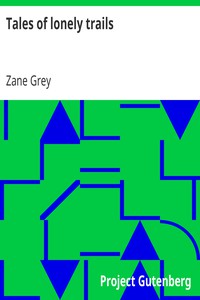Tales of lonely trails by Zane Grey (free novel 24 .TXT) 📕

Read free book «Tales of lonely trails by Zane Grey (free novel 24 .TXT) 📕» - read online or download for free at americanlibrarybooks.com
- Author: Zane Grey
Read book online «Tales of lonely trails by Zane Grey (free novel 24 .TXT) 📕». Author - Zane Grey
That night we camped at Bubbling Spring, which once had been a geyser of considerable power. Wetherill told a story of an old Navajo who had lived there. For a long time, according to the Indian tale, the old chief resided there without complaining of this geyser that was wont to inundate his fields. But one season the unreliable waterspout made great and persistent endeavor to drown him and his people and horses. Whereupon the old Navajo took his gun and shot repeatedly at the geyser, and thundered aloud his anger to the Great Spirit. The geyser ebbed away, and from that day never burst forth again.
Somewhere under the great bulge of Navajo Mountain I calculated that we were coming to the edge of the plateau. The white bobbing pack-horses disappeared and then our extra mustangs. It is no unusual thing for a man to use three mounts on this trip. Then two of our Indians disappeared. But Wetherill waited for us and so did Nas ta Bega, the Piute who first took Wetherill down into Nonnezoshe Boco. As I came up I thought we had indeed reached the end of the world.
"It's down in there," said Wetherill, with a laugh.
Nas ta Bega made a slow sweeping gesture. There is always something so significant and impressive about an Indian when he points anywhere. It is as if he says, "There, way beyond, over the ranges, is a place I know, and it is far." The fact was that I looked at the Piute's dark, inscrutable face before I looked out into the void.
My gaze then seemed impelled and held by things afar, a vast yellow and purple corrugated world of distance, apparently now on a level with my eyes. I was drawn by the beauty and grandeur of that scene; and then I was transfixed, almost by fear, by the realization that I dared to venture down into this wild and upflung fastness. I kept looking afar, sweeping the three-quarter circle of horizon till my judgment of distance was confounded and my sense of proportion dwarfed one moment and magnified the next.
Wetherill was pointing and explaining, but I had not grasped all he said.
"You can see two hundred miles into Utah," he went on. "That bright rough surface, like a washboard, is wind-worn rock. Those little lines of cleavage are canyons. There are a thousand canyons down there, and only a few have we been in. That long purple ragged line is the Grand Canyon of the Colorado. And there, that blue fork in the red, that's where the San Juan comes in. And there's Escalante Canyon."
I had to adopt the Indian's method of studying unlimited spaces in the desert—to look with slow contracted eyes from near to far.
The pack-train and the drivers had begun to zigzag down a long slope, bare of rock, with scant strips of green, and here and there a cedar. Half a mile down, the slope merged in what seemed a green level. But I knew it was not level. This level was a rolling plain, growing darker green, with lines of ravines and thin, undefined spaces that might be mirage. Miles and miles it swept and rolled and heaved, to lose its waves in apparent darker level. Round red rocks stood isolated. They resembled huge grazing cattle. But as I gazed these rocks were strangely magnified. They grew and grew into mounds, castles, domes, crags, great red wind-carved buttes. One by one they drew my gaze to the wall of upflung rock. I seemed to see a thousand domes of a thousand shapes and colors, and among them a thousand blue clefts, each of which was a canyon.
Beyond this wide area of curved lines rose another wall, dwarfing the lower; dark red, horizon-long, magnificent in frowning boldness, and because of its limitless deceiving surfaces incomprehensible to the gaze of man. Away to the eastward began a winding ragged blue line, looping back upon itself, and then winding away again, growing wider and bluer. This line was San Juan Canyon. I followed that blue line all its length, a hundred miles, down toward the west where it joined a dark purple shadowy cleft. And this was the Grand Canyon of the Colorado. My eye swept along with that winding mark, farther and farther to the west, until the cleft, growing larger and closer, revealed itself as a wild and winding canyon. Still farther westward it split a vast plateau of red peaks and yellow mesas. Here the canyon was full of purple smoke. It turned, it closed, it gaped, it lost itself and showed again in that chaos of a million cliffs. And then it faded, a mere purple line, into deceiving distance.
I imagined there was no scene in all the world to equal this. The tranquillity of lesser spaces was here not manifest. This happened to be a place where so much of the desert could be seen and the effect was stupendous Sound, movement, life seemed to have no fitness here. Ruin was there and desolation and decay. The meaning of the ages was flung at me. A man became nothing. But when I gazed across that sublime and majestic wilderness, in which the Grand Canyon was only a dim line, I strangely lost my terror and something came to me across the shining spaces.
Then Nas ta Bega and Wetherill began the descent of the slope, and the rest of us followed. No sign of a trail showed where the base of the slope rolled out to meet the green plain. There was a level bench a mile wide, then a ravine, and then an ascent, and after that, rounded ridge and ravine, one after the other, like huge swells of a monstrous sea. Indian paint brush vied in its scarlet hue with the deep magenta of cactus. There was no sage. Soap weed and meager grass and a bunch of cactus here and there lent the green to that barren, and it was green only at a distance.
Nas ta Bega kept on at a steady gait. The sun climbed. The wind rose and whipped dust from under the mustangs. There is seldom much talk on a ride of this nature. It is hard work and everybody for himself. Besides, it is enough just to see; and that country is conducive to silence. I looked back often, and the farther out on the plain we rode the higher loomed the plateau we had descended; and as I faced ahead again, the lower sank the red-domed and castled horizon to the fore.
It was a wild place we were approaching. I saw piñon patches under the circled walls. I ceased to feel the dry wind in my face. We were already in the lee of a wall. I saw the rock squirrels scampering to their holes. Then the Indians disappeared between two rounded corners of cliff.
I rode round the corner into a widening space thick with cedars. It ended in a bare slope of smooth rock. Here we dismounted to begin the ascent. It was smooth and hard, though not slippery. There was not a crack. I did not see a broken piece of stone. Nas ta Bega and Wetherill climbed straight up for a while and then wound round a swell, to turn this way and that, always going up. I began to see similar mounds of rock all around me, of every shape that could be called a curve. There were yellow domes far above and small red domes far below. Ridges ran from one hill of rock to another. There were no abrupt breaks, but holes and pits and caves were everywhere, and occasionally deep down, an amphitheater green with cedar and piñon. We found no vestige of trail on those bare slopes.
Our guides led to the top of the wall, only to disclose to us another wall beyond, with a ridged, bare, and scalloped depression between. Here footing began to be precarious for both man and beast. Our mustangs were not shod and it was wonderful to see their slow, short, careful steps. They knew a great deal better than we what the danger was. It has been such experiences as this that have made me see in horses something besides beasts of burden. In the ascent of the second slope it was necessary to zigzag up, slowly and carefully, taking advantage of every bulge and depression.
Then before us twisted and dropped and curved the most dangerous slopes I had ever seen. We had reached the height of the divide and many of the drops on this side were perpendicular and too steep for us to see the bottom.
At one bad place Wetherill and Nas ta Bega, with Joe Lee, a Mormon cowboy with us, were helping one of the pack-horses named Chub. On the steepest part of this slope Chub fell and began to slide. His momentum jerked the rope from the hands of Wetherill and the Indian. But Joe Lee held on. Joe was a giant and being a Mormon he could not let go of anything he had. He began to slide with the horse, holding back with all his might.
It seemed that both man and beast must slide down to where the slope ended in a yawning precipice. Chub was snorting or screaming in terror. Our mustangs were frightened and rearing. It was not a place to have trouble with horses.
I had a moment





Comments (0)